6172RB Science a STEM approach Year 2 low res watermark
You also want an ePaper? Increase the reach of your titles
YUMPU automatically turns print PDFs into web optimized ePapers that Google loves.
Lesson 1<br />
Physical sciences<br />
FORCED TO MOVE<br />
Teacher notes<br />
<strong>Science</strong> inquiry focus:<br />
What is a force and what does it do?<br />
<strong>Science</strong> Inquiry Skills:<br />
• Questioning and predicting QP<br />
• Planning and conducting PC<br />
• Processing and analysing data and<br />
information PA<br />
• Evaluating E<br />
• Communicating C<br />
<strong>Science</strong> as a Human Endeavour:<br />
• Students identify how we use forces in our<br />
everyday lives to change the position, size or<br />
shape of a stationary object or to change an<br />
object’s direction while in motion.<br />
Background information<br />
• A force is a push or pull that is applied by a<br />
person, another object or an invisible force,<br />
such as gravity, to change a stationary or<br />
moving object’s position, direction, shape or<br />
size.<br />
• A push is a force that moves objects away from<br />
that which is applying the force.<br />
• A pull is a force that moves objects closer to that<br />
which is applying the force.<br />
• Gravity is an invisible force that acts on all<br />
objects. It is a force that pulls objects towards<br />
the centre of the Earth. Students commonly<br />
believe that gravity does not work on objects<br />
that are sitting on a surface, such as a table. It<br />
is important to show students that when the<br />
surface is removed, gravity will act on the object.<br />
• The direction of force applied to an object, the<br />
amount of force applied and the properties of<br />
the material each object is made from affects<br />
whether the object changes position, direction,<br />
shape or size, and the amount of change that<br />
will occur.<br />
Technology/Engineering/Mathematics links:<br />
• taking digital photographs of playdough<br />
that has been changed by applying force<br />
• uploading and <strong>res</strong>izing digital<br />
photographs and inserting them into a<br />
computer program (optional)<br />
• participating in an online quiz<br />
Assessment focus:<br />
• Use each group’s digital photographs<br />
to assess the student’s ability to fol<strong>low</strong><br />
instructions to conduct a simple<br />
experiment.<br />
• Use the student’s answers to the online<br />
quiz to assess their understanding of<br />
the meaning of a force, a push, a pull<br />
and gravity; and their knowledge of how<br />
objects change their position, direction,<br />
size or shape when a force is applied.<br />
Resources<br />
• A b<strong>low</strong>n-up balloon for each pair<br />
• A packet of sticky notes for each pair<br />
• An A3 piece of blank paper for each<br />
pair<br />
• Online video—Gravity, force and work<br />
at <br />
• A medium-sized ball of playdough<br />
for each group. Students will divide<br />
this amount between four group<br />
members so that each student has a<br />
small ball of playdough each<br />
• Four counters for each group<br />
• Four rulers for each group<br />
• One copy of the cards on page 116<br />
for each group. These will need to be<br />
cut out prior to the lesson<br />
• A digital camera or iPad® for each<br />
group<br />
• Computer access for each group<br />
(optional)<br />
• Online quiz—Forces quiz at or a copy of<br />
page 117 for each student<br />
© R.I.C. Publications<br />
Low <strong>res</strong>olution display copy<br />
114 <strong>Science</strong>:<br />
A <strong>STEM</strong> APPROACH<br />
YEAR<br />
2<br />
978-1-925431-95-7 R.I.C. Publications® – www.ricpublications.com.au


















